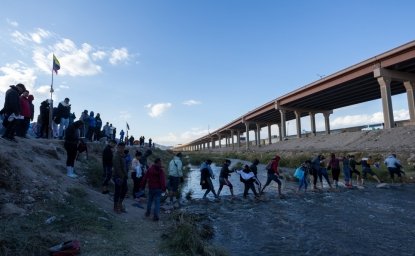The New Reality at the Border
In this op-ed from the Los Angeles Times, Andrew Selee argues that illegal immigration is'nt what it used to be. As Congress debates immigration reform, it is worth taking a look at what's changed.
In this op-ed from the Los Angeles Times, Andrew Selee argues that illegal immigration is'nt what it used to be. As Congress debates immigration reform, it is worth taking a look at what's changed.

The image of illegal immigration in the minds of most Americans is of poor Mexicans streaming across the Southwest border. This is not entirely wrong, but it is outdated. As Congress debates immigration reform, it is worth taking a look at what's changed. Mexican illegal immigration flows have been dropping steadily and seem to be continuing a downward trend even as the U.S. economy recovers. There are reasons to believe this trend is becoming permanent.
For most of the 1990s and early 2000s, most unauthorized immigrants crossed the Southwest border, and most years 90% to 95% were Mexicans. Since as far back as 2007, however, the numbers in the Southwest — and, in particular, the number of Mexicans — have been declining rapidly. Illegal border crossings there are now down to levels not seen in 40 years, and in 2012, more than a quarter of unauthorized Southwest border crossers were what the government calls "Other Than Mexicans," mostly Central Americans and a few immigrants from outside the hemisphere.
Three factors have slowed illegal immigration from Mexico. First, border security appears to have produced a deterrent effect. The budget of the Border Patrol has increased almost tenfold since 1993, and there are five times as many agents on the border, who now have access to an impressive array of technology. A recent report from the nonpartisan Washington-based Migration Policy Institute found that the U.S. government now spends more on immigration enforcement than all other federal law enforcement agencies combined — including the FBI, the Drug Enforcement Administration, the Bureau of Alcohol, Tobacco, Firearms and Explosives, the Secret Service and the U.S. Marshals Service. As a result, arrests of illegal border crossers last year were only a third of those recorded six years ago, back to levels last seen in 1972. The message appears to have reached communities in Mexico that it is expensive, difficult and dangerous to cross without papers.
Second, the Mexican economy has far outperformed expectations in recent years, creating incentives for people to stay in their home communities. Mexico has had 15 years of sustained economic growth, with a 3% average annual increase in GDP per capita. As a result, the average income of Mexicans has more than doubled in real terms since 1997 and is now similar to average income in Russia, Romania, Turkey, Malaysia and Brazil; twice what it is in China; and five times what it is in India. Although the wage gap between Mexicans and U.S. citizens is still high — a little over 4 to 1 — it is far better than the 7-to-1 wage gap of the 1990s.
Social programs have also improved, with one cash transfer program, Oportunidades, which is tied to keeping children in school and getting regular health checkups, now reaching more than a quarter of households. At the same time, Mexican migrants have played a vital role in stimulating the economy in the communities they left behind. Immigrants from the Mexican state of Zacatecas who now live in Southern California joined together to help build a university campus in the city of Jerez, one of the poorest in the state and a perennial source of migrants. They have started more than 20 new small businesses, supported by investment from Zacatecans living in and around Los Angeles, sometimes complemented by low-cost government loans. Today, thousands of young people in that state, who might otherwise have traveled north, are pursuing a college education or working in one of these businesses.
Finally, the demographic profile of Mexico is changing. The number of Mexicans ages 15 to 29 — those most likely to migrate — has stabilized over the last few years and will soon begin to drop. Heavy public and private investments in family planning programs in the 1970s and '80s have reduced the birthrate to a level similar to that of the United States. If this demographic shift hasn't contributed yet to the decline in migration from Mexico, it certainly will over the next decade.
What all this means is that, in the future, the largest illegal immigration flows are likely to come from parts of the world farther away than Mexico, including Central America and Asia. Because of distance, these flows will be smaller, but they will also require new and different enforcement measures, focused more on the workplace than on the border itself. And if Congress creates work-based visas for potential immigrants, as in the guest worker program now under discussion in the Senate, the numbers who are willing to risk an illegal crossing — from Mexico and elsewhere — are sure to drop even more.
There will always be some illegal immigration from Mexico to the U.S., as long as the wage gap between the two countries remains high. But in assessing U.S. policy reforms and in planning for the future, Americans need to revamp their image of who wants in, where they're coming from and why. Illegal immigration isn't what it used to be.


The Mexico Institute seeks to improve understanding, communication, and cooperation between Mexico and the United States by promoting original research, encouraging public discussion, and proposing policy options for enhancing the bilateral relationship. A binational Advisory Board, chaired by Luis Téllez and Earl Anthony Wayne, oversees the work of the Mexico Institute. Read more


The Wilson Center’s prestigious Latin America Program provides non-partisan expertise to a broad community of decision makers in the United States and Latin America on critical policy issues facing the Hemisphere. The Program provides insightful and actionable research for policymakers, private sector leaders, journalists, and public intellectuals in the United States and Latin America. To bridge the gap between scholarship and policy action, it fosters new inquiry, sponsors high-level public and private meetings among multiple stakeholders, and explores policy options to improve outcomes for citizens throughout the Americas. Drawing on the Wilson Center’s strength as the nation’s key non-partisan policy forum, the Program serves as a trusted source of analysis and a vital point of contact between the worlds of scholarship and action. Read more


